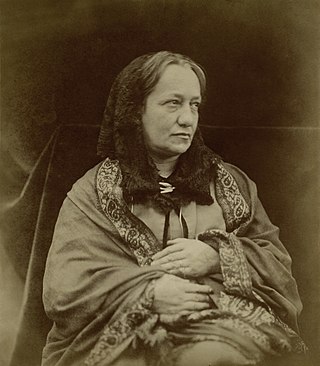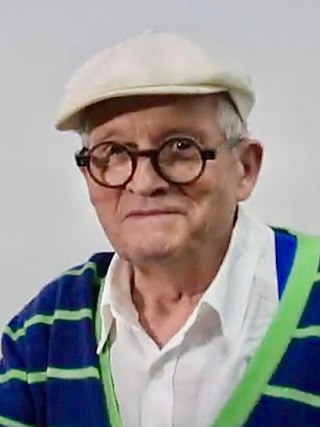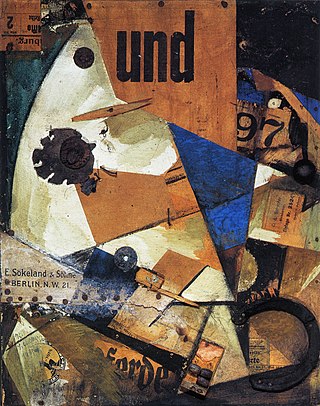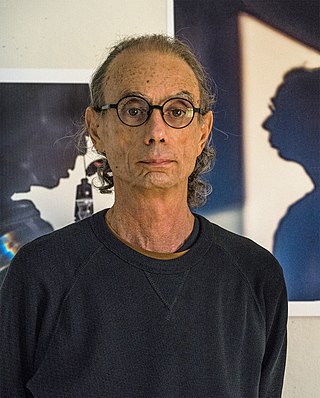
Photomontage is the process and the result of making a composite photograph by cutting, gluing, rearranging and overlapping two or more photographs into a new image. Sometimes the resulting composite image is photographed so that the final image may appear as a seamless physical print. A similar method, although one that does not use film, is realized today through image-editing software. This latter technique is referred to by professionals as "compositing", and in casual usage is often called "photoshopping". A composite of related photographs to extend a view of a single scene or subject would not be labeled as a montage, but instead a stitched image or a digital image mosaic.

Julia Margaret Cameron was an English photographer who is considered one of the most important portraitists of the 19th century. She is known for her soft-focus close-ups of famous Victorians and for illustrative images depicting characters from mythology, Christianity, and literature.

David Hockney is an English painter, draughtsman, printmaker, stage designer, and photographer. As an important contributor to the pop art movement of the 1960s, he is considered one of the most influential British artists of the 20th and 21st centuries.

The cyanotype is a slow-reacting, photographic printing formulation sensitive to a limited near ultraviolet and blue light spectrum, the range 300 nm to 400 nm known as UVA radiation. It produces a monochrome, blue coloured print on a range of supports, often used for art, and for reprography in the form of blueprints. For any purpose, the process usually uses two chemicals: ferric ammonium citrate or ferric ammonium oxalate, and potassium ferricyanide, and only water to develop and fix. Announced in 1842, it is still in use.
Irving Penn was an American photographer known for his fashion photography, portraits, and still lifes. Penn's career included work at Vogue magazine, and independent advertising work for clients including Issey Miyake and Clinique. His work has been exhibited internationally and continues to inform the art of photography.

Fine-art photography is photography created in line with the vision of the photographer as artist, using photography as a medium for creative expression. The goal of fine-art photography is to express an idea, a message, or an emotion. This stands in contrast to representational photography, such as photojournalism, which provides a documentary visual account of specific subjects and events, literally representing objective reality rather than the subjective intent of the photographer; and commercial photography, the primary focus of which is to advertise products or services.
Masumi Hayashi was an American photographer and artist who taught art at Cleveland State University, in Cleveland, Ohio, for 24 years. She won a Cleveland Arts Prize; three Ohio Arts Council awards; a Fulbright fellowship; awards from National Endowment for the Arts, Arts Midwest, and Florida Arts Council; as well as a 1997 Civil Liberties Educational Fund research grant.

Anne Wardrope Brigman was an American photographer and one of the original members of the Photo-Secession movement in America.

Collage is a technique of art creation, primarily used in the visual arts, but in music too, by which art results from an assemblage of different forms, thus creating a new whole.

The Sunday Times Magazine is a magazine included with The Sunday Times. In 1962 it became the first colour supplement to be published as a supplement to a UK newspaper, and its arrival "broke the mould of weekend newspaper publishing".
Emy Kat is a researcher, visual artist and photographer working in contemporary art and fine art photography.
Nigel Graeme Henderson (1 April 1917 – 15 May 1985) was an English documentary artist, and photographer.

Steve Sabella is a Berlin-based artist who uses photography and photographic installation as his principle modes of expression, and author of the memoir The Parachute Paradox, published by Kerber Verlag in 2016.
Mark Strizic was a 20th-century German-born Australian photographer, teacher of photography, and artist. Best known for his architectural and industrial photography, he was also a portraitist of significant Australians, and fine art photographer and painter known for his multimedia mural work.
Susanne Helene Ford was an Australian feminist photographer who started her arts practice in the 1960s. She was the first Australian photographer to have a solo exhibition at the National Gallery of Victoria in 1974 with Time Series. A book of her portraits of women 'A Sixtieth of a Second' was published in 1987. Her photographs and eclectic practice was displayed in an exhibition at the National Gallery of Victoria in 2014.
David Campany is a British writer, curator, artist and educator, working mainly with photography. He has written and edited books; contributed essays and reviews to other books, journals, magazines and websites; curated photography exhibitions; given public lectures, talks and conference papers; had exhibitions of his own work; and been a jury member for photography awards. He has taught photographic theory and practice at the University of Westminster, London. Campany is Managing Director of Programs at the International Center of Photography in New York City.
Bruce Bernard was an English picture editor, writer and photographer. He wrote for the Sunday Times and the Independent and photographed many influential artists in a career lasting nearly 40 years. Some of Bernard's prints are held in the collection of the National Portrait Gallery, London.
Matt Lipps is an American photographer and artist.

David Lebe is an American photographer. He is best known for his experimental images using techniques such as pinhole cameras, hand-painted photographs, photograms, and light drawings. Many of his photographs explore issues of gay identity, homoeroticism, and living with AIDS, linking his work to that of contemporaries such as Robert Mapplethorpe, Peter Hujar, and David Wojnarowicz. Though his style and approach set him apart from these contemporaries, "Lebe is now incontrovertibly part of the history of twentieth-century queer artists."
Paul Joyce is a British photographer and filmmaker. His portraits of artists are held in the collection of the National Portrait Gallery, London and his Welsh landscape photographs are held in the collection of Amgueddfa Cymru – Museum Wales.










